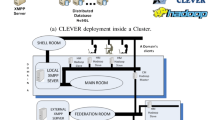Abstract
Social media streaming has become one of the most popular applications over the Internet. We have witnessed the successful deployment of commercial systems with CDN (Content Delivery Network)- based engines, but they suffer from excessive costs for deploying dedicated servers. And with the further expansions on network traffic of social media streaming, a cost-effective solution remains an illusive goal. The emergence of cloud computing sets out to meet the challenge by dynamically leasing cloud servers. This paper aims to realize the capacity migration of social media systems to clouds at the reduced cost. Firstly, by lowering the capacity requested from clouds to reduce the capacity migration cost. Based on the crawled data from YouTube which is the most representative online social media, we find that with larger than 90% probability, the YouTube user’s all requested videos are within three hops of related videos. Then the three hops of related videos are regarded as a cluster and a user’s request can be partly satisfied by other users who watch videos in the same cluster to lessen the capacity requested from clouds. Therefore the capacity migration for clusters is under the P2P (Peer-to-Peer) paradigm and a cloud-assisted P2P social media system is proposed. Secondly, given the diverse capacities, cost, limited lease size of cloud servers, we formulate an optimization problem about how to lease cloud servers to minimize the leasing cost and a heuristic solution is presented. The evaluation based on the crawled data from a cluster of YouTube videos shows the efficiency of the proposed schemes.










Similar content being viewed by others
Explore related subjects
Discover the latest articles and news from researchers in related subjects, suggested using machine learning.References
YouTube serves up 100 million videos a day online. http://www.usatoday.com/tech/news/2006-07-16-youtube-views_x.htm. Online accessed 5 Dec 2011
Web could collapse as video demand soars. http://www.telegraph.co.uk/news/uknews/1584230/Web-could-collapse-as-video-demand-soars.html. Online accessed 5 Dec 2011
Corbett C (2006) Peering of video. http://www.nanog.org/mtg-0606/pdf/bill.norton.3.pdf. Accessed 5 Oct 2008
Armbrust M, Fox RGA, Joseph AD, Katz RH, Konwinski A, Lee G, Patterson DA, Rabkin A, Stoica I, Zaharia M (2007) Above the clouds: a berkeley view of cloud computing. University of California, Berkeley, Tech. Rep
Li A, Yang X, Kandula S, Zhang M (2010) CloudCmp: comparing public cloud providers. In: Proceedings of ACM IMC
Cheng X, Dale C, Liu J (2008) Statistics and social network of YouTube videos. In: Proceedings of IEEE IWQoS
Wu Y, Wu C, Li B, Qiu X, Lau FC (2011) CloudMedia: when cloud on demand meets video on demand. In: Proceedings of IEEE ICDCS
Wang F, Liu J, Chen M (2012) CALMS: migration towards cloud-assisted live media streaming. In: Proceedings of IEEE INFOCOM
Li H, Zhong L, Liu J, Li B, Xu K (2011) Cost-effective partial migration of vod services to content clouds. In: Proceedings of IEEE cloud
Cheng X, Liu J (2011) Load-balanced migration of social media to content clouds. In: Proceedings of ACM NOSSDAV
Box GE, Jenkins MG, Reinsel GC (2008) Time series analysis: forecasting and control. Wiley
Kellerer H, Pferschy U, Pisinger D (2004) Knapsack problems. Springer
Amazon Elastic Compute Cloud. http://aws.amazon.com/ec2/. Online accessed 15 Dec 2011
Pandey S, Wu L, Guru S, Buyya R (2010) A particle swarm optimization (PSO)-based heuristic for scheduling workflow applications in cloud comuputing environment. In: Proceedings of IEEE AINA
Xiao Y, Lin C, Jiang Y, Chu X, Shen S (2010) Reputation-based QoS provisioning in cloud computing via Dirichlet multinomial model. In: Proceedings of IEEE ICC
Peixoto MLM, Santana MJ, Estrella JC, Tavares TC, Kuehne BT, Santana RHC (2010) A metascheduler architecture to provide QoS on the cloud computing. In: Proceedings of IEEE ICT
Yu S, Wang C, Ren K, Lou W (2010) Achieving secure, scalable, and fine-grained data access control in cloud computing. In: Proceedings of IEEE INFOCOM
Wang C, Wang Q, Ren K, Lou W (2010) Privacy-preserving public auditing for data storage security in cloud computing. In: Proceedings of IEEE INFOCOM
Urgaonkar R, Kozat UC, Igarashi K, Neely MJ (2010) Dynamic resource allocation and power management in virtualized data centers. In: Proceedings of IEEE/IFIP NOMS
Amazon Simple Storage Service. http://aws.amazon.com/s3/. Online accessed 15 Dec 2011
Acknowledgements
This paper is sponsored by Information Engineering Project of He Nan Province under Grant No. 2008xxh001 and Innovation Project of He Nan Province under Grant No. 2011HASTIT003 with Zhengzhou University.
Author information
Authors and Affiliations
Corresponding author
Rights and permissions
About this article
Cite this article
Zhang, Q., Lin, Y. & Wang, Z. Cost-effective capacity migration of Peer-to-Peer social media to clouds. Peer-to-Peer Netw. Appl. 6, 247–256 (2013). https://doi.org/10.1007/s12083-012-0148-4
Received:
Accepted:
Published:
Issue Date:
DOI: https://doi.org/10.1007/s12083-012-0148-4




